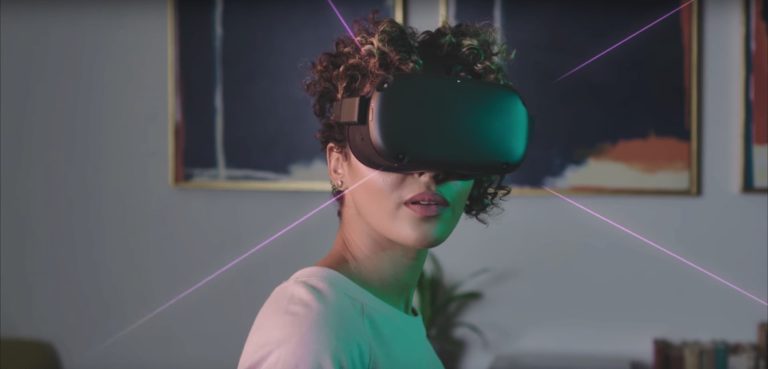
For the average user, getting into virtual reality (VR) for the first time can be intimidating. Even if you’re familiar with computers and how they work, you’ll suddenly find yourself steeped in an entirely new language. Inputs. Haptics. Frame Rate. Field of view. Resolution. The list goes on.
It’s easy to get lost in this new vocabulary, but for the moment, we’re going to focus on two of them: field of view (FOV) and resolution. What do these two terms describe? And how do they interact with the science of the human eye?
Defining Resolution in Virtual Reality
Resolution is a phrase that extends beyond VR, and you’re probably already familiar with the concept. Resolution is defined as the number of pixels that can be displayed. The 1920 x 1080 designation on your computer monitor is the device’s resolution. In this case, a landscape-orientation monitor is 1920 pixels wide and 1080 pixels high.
On a 27-inch monitor, that might not seem like much. On a VR screen measuring 3.4 or 3.6 inches, that is a lot of pixel density. However there’s a tradeoff, in that your eyes’ proximity to those tiny screens means that greater resolution is needed to avoid the dreaded screen door effect.
Defining Field of View in Virtual Reality
Field of view, in a broad sense, is the extent of the observable environment that you’re able to see at any given moment. If you’re using your eyes, your field of view extends from one edge of your peripheral vision to the other. Turning your head shifts your field of view, but doesn’t increase your actual FOV.
In a VR headset, the goal is to provide you with the largest FOV possible, but there’s no point in creating a field of view wider than the human eye can track. With the average set of human eyes, each eye provides about 130 degrees of overlapping FOV, totaling around 180 degrees.
The Science of the Human Eye
Ever wonder why the pictures you take with your cellphone never manage to quite catch the sheer beauty of whatever you’re trying to capture? That’s because the camera on your phone only captures a handful of megapixels. Some of the best phone cameras on the market right now only have a 12-25 MP lens. The human eye captures images in 576 megapixels.
The eye is also transmitting massive amounts of data to the brain. A study conducted at UPenn’s School of Medicine in 2006 found that the retina is capable of transmitting up to 10 million bits of data every second back to the brain. That’s roughly the same transmission speed you’d find in an Ethernet cable connection.
Improving VR Immersion
Understanding these three components — resolution, field of view, and the science of the human eye — gives programmers and designers the tools that they need to create a truly immersive experience. Video resolution that’s too low will create a blurry experience that will prevent the user from being able to immerse themselves in the virtual world. Along the same lines, if the field of view is too narrow, users will find themselves boxed in, which breaks the illusion of VR.
There are several components that go into creating a more immersive virtual experience. Some of the best VR headsets today offer around 210-degree fields of view, and high resolution spread across both eyes. Current standounts include the 2.3 megapixel Valve Index (1,440 x 1,600 per-eye LCD) and the 4.7 megapixel HP Reverb G2 (2,160 x 2,160 per-eye LCD). Meanwhile, Varjo’s headsets have become the gold standard in VR resolution including the new consumer-geared Aero (2,880 x 2,720 per-eye LCD).
To simulate additional levels of VR presence, some die-hards use fans to move air around them or even burn scented candles to create a more immersive feeling as they explore virtual worlds. Eventually, we may have access to full-dive VR similar to what you see in Ready Player One or Sword Art Online, with haptic feedback suits that let us feel it when we interact with the virtual world. Elon Musk is even working on a project called Neuralink that will allow users to control their avatars with the power of the mind rather than a keyboard or controller.
Which Is More Important?
When it comes down to it, is the resolution or the field of view more important for a good VR system? The answer is both, for two completely different reasons. You need a clear high-resolution picture, and you also need an expansive field of view that mimics what you might see when you’re looking at the real world around you. Both of these features are equally important and will be vital when designing an immersive virtual experience.
However, while both FOV and resolution are necessary considerations for designing a user-friendly VR headset, some users have outsized preference for one or the other. Many VR enthusiasts agree that resolution is top priority for creating an experience that mimics real life. While players can more easily adjust to a lower FOV, many find it much harder to adjust to low-quality resolution. Some gamers, on the other hand, find they are unable to defend against opponents due to the opponent being out of their FOV. In this way, VR manufacturers must consider their audience when determining where to place their focus.
 April Miller is a senior writer at ReHack Magazine and editorial contributor at AR Insider. She specializes in VR/AR, IoT, and business technology. See her work here and follow her @rehackmagazine.
April Miller is a senior writer at ReHack Magazine and editorial contributor at AR Insider. She specializes in VR/AR, IoT, and business technology. See her work here and follow her @rehackmagazine.






